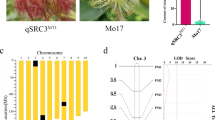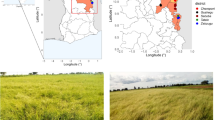Abstract
Grape skin color is among the most important qualitative traits on which selection is based in wine and table grape breeding programmes. Skin color is determined by the quantity and composition of anthocyanins. In prior work on cultivated forms, it was shown that polymorphisms in the grape transcription factor family VvMYBA are responsible for anthocyanin content variation in the berries of cultivated grapevine (Vitis vinifera subsp. vinifera). Wild grapevine (V. vinifera subsp. sylvestris) is the ancestor of the cultivated V. vinifera subsp. sativa and has black-colored berries. The purpose of this study was to determine how the VvmybA1 and VvmybA2 polymorphisms emerged and affected the genetic diversity of wild grapevines in the Mediterranean basin by examining samples from the Iberian Peninsula, Italian Peninsula and Caucasian region. Our observations provide evidence that variation in the two transcriptional regulators generated a novel allele series via length polymorphisms in VvmybA1 and a point mutation in VvmybA2, which is lacking in cultivated grapevine. Further, correlation was detected between allele composition and anthocyanin contents. According to polymorphisms in both VvMYBA genes at the color locus, we were able to identify several haplotypes. The most ancestral haplotype (HapN) was found in wild grapevine in the western Mediterranean region and corresponded to wine grape cultivars, whereas recent haplotypes were detected in eastern regions. These eastern zones showed the most diverse haplotypes, which appeared in table cultivars where intense breeding practices may have replaced the original haplotype diversity. These findings provide information about the evolution of grapes since their domestication and have direct implications for wine quality.


Similar content being viewed by others
References
Aradhya MK, Dangl GS, Prins BH, Boursiquot JM, Walker MA, Meredith CP et al (2003) Genetic structure and differentiation in cultivated grape, Vitis vinifera L. Genet Res 81:179–192
Arroyo García RA, Revilla E (2013) The current status of wild grapevine populations (Vitis vinifera ssp sylvestris) in the Mediterranean basin. In: Poljuha D, Slodanja B (eds) The Mediterranean genetic code—grapevine and olive. InTech, Rijeka, p 51–72
Arroyo-Garcia R, Ruiz-Garcia L, Bolling L, Ocete R, Lopez MA, Arnold C et al (2006) Multiple origins of cultivated grapevine (Vitis vinifera L. ssp sativa) based on chloroplast DNA polymorphisms. Molec Ecol 15:3707–3714
Azuma A, Kobayashi S, Mitani N, Shiraishi M, Yamada M et al (2008) Genomic and genetic analysis of Myb-related genes that regulate anthocyanin biosynthesis in grape berry skin. Theor Appl Genet 117:1009–1019
Azuma A, Udo Y, Sato A, Mitani N, Kono A, Ban Y, Yakushiji H, Koshita Y, Kobayashi S (2011) Haplotype composition at the color locus is a major genetic determinat of skin color variation in Vitis × labruscana grapes. Theor Appl Genet 122:1427–1438
Bacilieri R, Lacombe T, Le Cunff L, Di Vecchi-Staraz M, Laucou V, Genna B, Péros JP, This P, Boursiquot JM (2013) Genetic structure in cultivated grapevines is linked to geography and human selection. BMC Pl Biol 2013:25
Biagini B, De Lorenzis G, Scienza A, Failla O, Imazio S, Maghradze D (2012) Wild grapevine [Vitis vinifera L. subsp. sylvestris (Gmelin) Hegi] in Italy: distribution and preliminary genetic analysis. Acta Hort 948:211–216
Bourzeix M, Weyland D, Heredia N (1986) Etude des catechises et des procyanidols de la grapee de raisin du vin et d’autres derives de la vigne. Bull OIV 59:1171–1254
Brown GR, Gill GP, Kuntz RJ, Langley CH, Neale DB (2004) Nucleotide diversity and linkage disequilibrium in loblolly. Proc Natl Acad Sci USA 101:1525–1526
Cornish-Bowden A (1985) Nomemclature for incompletely specific bases in nucleic acid sequences recommendations. Nucl Acids Res 13:3021–3030
De Andres MT, Benito A, Ocete R, Lopez MA, Gaforio L, Muñoz G, Martinez-Zapater JM, Arroyo-Garcia R (2012) Genetic diversity of wild grapevine populations in Spain and their genetic relationship with cultivated grapevines. Molec Ecol 21:800–816
Dereeper A, Nicolas S, Le Cuff L, Bacilieri R, Doligez A, Peros JP, Ruz M, This P (2011) SNiPlay: a web based tool for detection, management and analysis of SNPs. Application to grapevine diversity projects. BMC Bioinformatics 12:134
Di Vecchi-Staraz M, Laucou V, Bruno G, Lacombe T, Gerber S (2009) Low level of pollen-mediated gene flow from cultivated to wild grapevine: consequences for the evolution of the endangered subspecies Vitis vinifera L. subsp silvestris. J Heredity 100:66–75
Dong QH, Cao X, Yang G, Yu HP, Nicholas KK, Wang C, Fang JG (2010) Discovery and characterization of SNPs in Vitis vinifera and genetic assessment of some grapevine cultivars. Sci Hort (Amsterdam) 125:233–238
Feller A, Machemer K, Braun E, Grotewold. E (2011) Evolutionary and comparative analysis of MYB and bHLH plant transcription factors. Pl J 66:94–116
Fournier-Level A, Le Cunff L, Gomez C, Doligez A, Ageorges A et al (2009) Quantitative genetic bases of anthocyanin variation in grape (Vitis vinifera L. ssp sativa) berry: a QTL to QTN integrated study. Genetics 183:1127–1139
Fournier-Level A, Lacombe T, Le Cunff L, Boursiquot JM, This P (2010) Evolution of the VvMYBA gene family, the major determinant of berry colour in cultivated grapevine (Vitis vinifera L.). Heredity 104:351–362
Garfi G et al (2013) Habitat features and genetic integrity of wild grapevine Vitis vinifera L. subsp. sylvestris (C.C. Gmel.) Hegi populations: a case study from Sicily. Flora 208:538–548
Grassi F, Labra M, Imazio S, Spada A, Sgorbati S, Scienza A, Sala F (2003) Evidence of a secondary grapevine domestication centre detected by SSR analysis. Theor Appl Genetics 107:1315–1320
Hall TA (1999) BioEdit: a user friendly sequence alignment editor and analysis program for Windows 95/98/NT. Nucleic Acid Res 41:95–98
Hancock JF (2004) Plant evolution and the origin of crop species. CABI Publishing, Wallingford
Huang YF, Bertrand Y, Guiraud JL, Vialet S, Amandine Launay A, Cheynier V, Terrier N, This P (2013) Expression QTL mapping in grapevine-Revising the genetic determinis of grape skin colour. Pl Sci 297:18–24
Imazio S, Maghradze D, De Lorenzis G et al (2013) From the cradle of grapevine domestication: molecular overview and description of Georgian grapevine (Vitis vinifera L.) germplasm. Tree Genet Genomes 9:641–658
Jk Bonfield, Smith KF, Staden R (1995) A new DNA sequence assembly program. Nucl Acid Res 23:4992–4999
Kobayashi S, Goto-Yamamoto N, Hirochika H (2004) Retrotransposon-induced mutations in grape skin color. Science 304:982
Kobayashi S, Goto-Yamamoto N, Hirochika H (2005) Association of VvmybA1 gene expression with anthocyanin production in grape (Vitis vinifera L) skin-color mutant. J Jap Soc Hort Sci 74:196–203
Laucou V, Lacombe T, Dechesne F, Siret R, Bruno JP, Dessup M, Dessup T, Ortigosa P, Parra P, Roux C, Santoni S, Vares D, Peros JP, Boursiquot JM, This P (2011) High throughput analysis of grape genetic diversity as a tool for germplasm collection management. Theor Appl Genet 122:1233–1245
Le Cunff L, Fournier-Level A, Laucou V, Vezzulli S, Lacombe T, Adam-Blondon AF et al (2008) Construction of nested genetic core collections to optimize the exploitation of natural diversity in Vitis vinifera L. subsp sativa. BMC Pl Biol 8:31
Levadoux L (1956) Les Populations sauvages et cultivées de Vitisvinifera L. Annales de l’amélioration des plantes, vol 1. INRA, Paris, p 59–119
Lijavetzky D, Ruiz-Garcia L, Cabezas JA, De Andres MT, Bravo G, Ibanez A et al (2006) Molecular genetics of berry colour variation in table grape. Molec Genet Genomics 276:427–435
Lijavetzky D, Cabezas JA, Ibañez A, Rodrıguez V, Martınez- Zapater JM (2007) High throughput SNP discovery and genotyping in grapevine (Vitis vinifera L.) by combining are-sequencing approach and SNPlex technology. BMC Genomics 8:424
Meyer RS, Purugganan MD (2013) Evolution of crop species: genetics of domestication and diversification. Nat Rev Genet 14:840–852
Mitani N, Azuma A, Fukai E, Hirochika H, Kobayashi S (2009) A retrotransposon-inserted VvmybA1a allele has been spread among cultivars of Vitis vinifera L but not North American or East Asian Vitis species. Vitis 48:55–56
Myles S, Boyko AR, Owens CL, Brown PJ, Grassi F, Aradhya MK, Prins B, Reynolds A, Chia JM, Ware D, Bustamante CD, Buckler ES (2011) Genetic structure and domestication history of the grape. Proc Natl Acad Sci USA 108:3530
Negrul AM (1938) Evolution of cultivated forms of grapes. Dokl Akad Nauk SSSR 18:585–588
Nei M, Tajima F (1987) Problems arising in phylogenetics inference from restriction site data. Molec Biol Evol 4:320–323
Niketic-Aleksic GK, Hrazdina G (1972) Quantitative analysis of the anthocyanin content in grape juices and wines. Lebensmittel-Wiss Technol 5:163–165
Olalde M, Herran A, Espinel S, Gocochea PG (2002) White oaks phylogeography in the Iberian Peninsula. Forest Ecol Managem 156:89–102
Olmo HP (1995) The origin, domestication of the vinifera grape. In: Mc Govern PE, Fleming SJ, Katz SH (eds) The origins and ancient history of wine. Gordon and Breach Publishers, Philadelphia, pp 23–30
Revilla E, Ryan JM, Martín-Ortega G (1998) Comparison of several procedures used for the extraction of anthocyanins from red grapes. J Agric Food Chem 46:4592–4597
Revilla E, Carrasco D, Benito A, Arroyo-Garcia R (2010) Anthocyanin composition of several wild grape accessions. Am J Enol Vit 61:636–642
Riahi L, Zoghlami N, Fournier-Level A, Le Cuff L, Laucou V, Mliki A, This P (2013) Characterization of single nucleotide polymorphism in Tunisian grapevine genome and their potential for population genetics and evolutionary studies. Genet Resources Crop Evol 60:1139–1151
Rozas J, Sanchez-Del Barrio JC, Messeguer X, Rozas R (2003) DnaSP, DNA polymorphism analyses by the coalescent and other methods. Bioinformatics 19:2496–2497
Shimazaki M, Fujita K, Kobayashi H, Suzuki S (2011) Pink-colored grape berry is the result of short insertion in intron of color regulatory gene. PLoS ONE 6:e21308
Snoussi H, Slimane MH, Ruiz-Garcia L, Martinez-Zapater JM, Arroyo-Garcia R (2004) Genetic relationship among cultivated and wild grapevine accessions from Tunisia. Genome 47(6):1211–1219
Stephens M, Scheet P (2005) Accounting for decay of linkage disequilibrium in haplotype inference and missing data imputation. Amer J Human Genet 76:449–462
Tajima F (1989) Statistical method for testing the neutral mutation hypothesis by DNA polymorphism. Genetics 123:585–595
This P, Lacombe T, Cadle-Davidson M, Owens CL (2007) Wine grape (Vitis vinifera L) color associates with allelic variation in the domestication gene VvmybA1. Theor Appl Genet 114:723–730
Velasco R, Zharkikh A, Troggio M, Cartwright DA, Cestaro A et al (2007) A high quality draft consensus sequence of the genome of a heterozygous grapevine variety. PLoS ONE 2:e1326
Walker AR, Lee E, Bogs J, McDavid DAJ, Thomas MR et al (2007) White grapes arose through the mutation of two similar and adjacent regulatory genes. Pl J 49:772–785
Watterson GA (1975) On the number of segregating sites in genetical models without recombination. Theor Populat Biol 7:256–276
Yakushiji H, Kobayashi S, Goto-Yamamoto N, Jeong ST, Mitani N, Azuma A (2006) A skin color mutation of grapevine from black-skiined “Pinot Noir”to white-skinned “Pinot Balanc” is caused by the deletion of the functional VvmybA1 alelle. Biosci Biotechnol Biochem 70:1506–1508
Zinelabine LH, Haddioui A, Bravo G, Arroyo-Garcia R, Martinez-Zapater JM (2010) Genetic origins of cultivated and wild grapevines from Morocco. Amer J Enol Viticult 61:1
Acknowledgments
This work was supported by the project grant RTA2011-00029-C01. AB holds an INIA fellowship for this project. This is a joint publication of the COST Action FA1003 “East–West Collaboration for Grapevine Diversity Exploration and Mobilization of Adaptive Traits for Breeding”.
Author information
Authors and Affiliations
Corresponding author
Additional information
Handling editor: Eric Schranz.
D. Carrasco and G. De Lorenzis equally contributed to this work.
Electronic supplementary material
Below is the link to the electronic supplementary material.
Rights and permissions
About this article
Cite this article
Carrasco, D., De Lorenzis, G., Maghradze, D. et al. Allelic variation in the VvMYBA1 and VvMYBA2 domestication genes in natural grapevine populations (Vitis vinifera subsp. sylvestris). Plant Syst Evol 301, 1613–1624 (2015). https://doi.org/10.1007/s00606-014-1181-y
Received:
Accepted:
Published:
Issue Date:
DOI: https://doi.org/10.1007/s00606-014-1181-y




